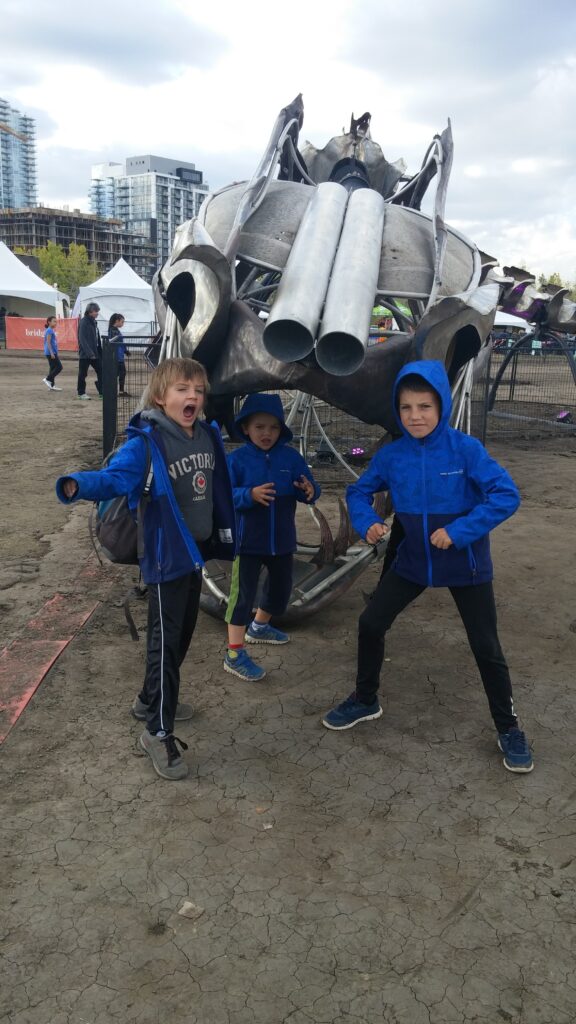
Growing up, children have a plethora of experiences that have to do with the concept of force. Even before they start talking and knowing the word “force” they have an intuitive understanding of the concept of push and pull. It doesn’t take long for a child to figure out that pushing their brother will result in him moving in the same direction. Babies realize from very early on that things fall down. (A common game among babies and parents is the “baby drops toy – parent picks up toy – repeat many times until parent loses patience”.) This environmental input of the force of gravity acting on an object, thus accelerating it towards the earth gets absorbed by the child’s awareness, and becomes second nature to the child. Most children will ask a parent about these phenomena. The parent then tries to explain these phenomena in terms of sophisticated words such as force, gravity, energy, power, and push / pull. The adult might go in depth or just quickly dismiss the inquiry, depending on the adult’s actual knowledge of the phenomenon, the parent’s interest in scientific principles, or even the time and place of the question. Based on these explanations, and the instances of hearing the words of force or gravity in context, children start to associate what force actually means in terms of their world around them. Their understanding however might not be in alignment with the physicist’s definition.
A very similar example can be given in terms of the term work. In physics, work is very specifically defined as “the scalar product of the force acting on an object and the displacement caused by that force”. A person making hamburgers at McDonald’s is doing work, as well as a researcher reading an article. But this is not the same as doing work as defined in physics. Therefore the word work in the ordinary sense has to be understood as completely different from its meaning in Newtonian mechanics. I would call these two meanings of work polysemes (i.e. a polyseme is a word or phrase with multiple but related meanings.)
In the same way, the word force has a different meaning in the colloquial sense compared to the official meaning as described in Newtonian physics. But because language is so tightly bound to our knowledge, this creates misconceptions about how and why objects move, and the forces acting on them. This also creates a major obstacle in teaching mechanics, and why I found this topic so compelling.
Thus, in this thought paper, I investigate conceptual change as related to the concept of force. More specifically, I compare the two theories of initial (mis)conceptions: Knowledge in Pieces (diSessa, Gillespie, Esterly, 2004) and the Framework Theory model (Vosniadou & Brewer 1992) on the basis of two very similar experiments, related to the same domain and concept of force, yet resulting in two completely different interpretations.
Conceptual change deals with how students change their understandings and misconceptions into standardized understandings of ideas. Conceptual change contrasts with less problematic learning such as skill and fact acquisition, as the latter don’t have to compete with already established theories / explanations of concepts. The primary difficulty is that students must build new ideas in the context of old ones, instead of simple acquisition. It is well documented, that these prior ideas constrain learning of the new ones (diSessa, 2006). To realize conceptual change, one must first understand the misconceptions, or in other words the initial knowledge structures. This is where the perspectives from the two articles disagree.
The (chronologically) first study (Ionnides & Vosnidou, 2002) sets out to investigate the initial knowledge structures for the concept of force of children ranging from preschool to high school. The results overwhelmingly show that most of the children made use of a small number of relatively well-defined and internally consistent interpretations of force. This study supports the Framework Theory model of conceptual development, where children’s intuitive ideas about the physical world, rather than being inconsistent and fragmented, represent a few, possibly naïve, yet coherent models. According to Vosindou (1994) the framework theory of physics is established early on in infancy and forms the basis of individuals’ ontology and epistemology. These frameworks act as constraints on the way individuals interpret their observations and the information they receive from culture to construct specific theories about the physical world. The specific theories formed through this process are continuously enriched and modified. Some kinds of conceptual change require the simple addition of new information to an existing conceptual structure. Others are accomplished only when existing beliefs and presuppositions are revised.
According to this framework theory, misconceptions are interpreted as individuals’ attempts to assimilate new information into existing conceptual structures that contain information contradictory to the scientific view (Vosniadou, 1994). The results from the Ionnides and Vosindou (2002) support this view, as they demonstrated that even though the older students were exposed to the teachings of Newtonian mechanics at school, they did not fully reject their naïve theory of force, and only seemed to have a “hybrid” understanding of force, using both naïve and synthetic meanings.
The second study (diSessa, Gillespie, & Esterly, 2004), sets out to duplicate the empirical study of Ionnides & Vonidou of 2002, and extend it to illustrate the opposing theory of initial conceptions being fragmented as opposed to coherent models. This view, termed Knowledge in Pieces, envisions that intuitive physics is made up mostly of hundreds or thousands of self-explanatory schemata, typically abstracted from common situations, called phenomenological primitives (p-prims). DiSessa (1993) speculates that p-prims are explanatorily primitive, provide people with their sense of which events are natural, and need no explanation, which are surprising, and why. In a specific domain, p-prims are loosely organized, and sometimes highly contextual, so that the word “theory” is inappropriate (diSessa, 2006).
The results of the second study are very intriguing. Even though the intent of the authors was to replicate Ionnides’ & Vosnidou’s study, diSessa, Gillespie, and Esterly (2004) got conflicting results, even before the interpretation. In fact they found that children do not make use of a small number of relatively well-defined and internally consistent interpretations of force, as Ionnides & Vosnidou contended. Instead, they found that children have many, “fragmented” understandings of force.
Accordingly, the extension study found that when context and specification of a concept was introduced into the questions of the experimental design, the coherent models no longer existed (with even more fragmented results than in the quasi-replication of the study) (diSessa, Gillespie, & Esterly, 2004). For instance, when subjects were asked about forces in two different contexts (e.g. a ball travelling around in a circle in a tube compared to a ball travelling around in a circle held by a string), they saw the two situations as different in terms of what forces were present, yet in Newtonian physics, they would be considered equivalent. Also, when the specifications of the force concept were defined and probed, the differentiation of the responses rose significantly, and therefore supported the “fragmentation” hypothesis.
This debate is not inconsequential. Depending on the way we interpret misconceptions of force leads to different ways of teaching students Newtonian mechanics. The “coherence” view suggests the naive theory competes with the established scientific theory, thus the process involves the enrichment of the initial theories as well as their major reorganization (Ionnides & Vosnidou, 2002). On the other hand, the “fragmented” view suggests integration of p-prims into the theory, as collecting and systematizing the fragments of knowledge into consistent wholes (diSessa, 1993). Thus figuring out which side is the “true” theory, might lead to a resolution to overcoming the misconceptions when teaching Newtonian physics.
However, the comparison of these two articles also shows several other aspects not related to instruction or even physics misconceptions. First of all, it demonstrates an interesting debate in the open forum of the scientific knowledge building community. Initially, Ioannides and Voniadou (2002) put great emphasis on how their results directly contradict diSessa’s Knowledge by Pieces theory. This in turn triggered a reaction from diSessa and her colleagues. Yet seeing some merit to their argumentation and empirical results, diSessa, Gillespie, & Esterly, (2004), had to redefine and be more specific with certain aspects of their theory (e.g. the concept of “fragmentation” is redefined and presented in terms of contextualization and specification of the concept). Thus there is a refinement of ideas, and a fine-tuning of the theory. With every iteration, the theories improve.
Another interesting point is the fact that diSessa’s quasi-replication of Ioannides’ and Voniadou’s experiment yielded opposing results, even though the intention was to duplicate the experiment. DiSessa, Gillespie and Esterly (2004) state a few hypotheses for this discrepancy, namely: interviewing techniques, coding, instructional differences, and language (first study done in Greek the other in English). Yet from their elaboration on each of these possibilities, none of the differences should produce such significant outcomes. I find this extremely fascinating. Coming from a scientific background, replicability of an experiment is one of the most important features of science. So can these studies be considered scientifically valid? This brings back the question, whether it is appropriate to study humans, and their various practices such as learning, out of context, with traditional scientific methods? Possibly this failure to replicate the original results is a motivation to switch to design experiments instead of traditional experiments in the lab.
Finally, this comparison reveals how sensitive complex systems are to their initial variables. The few initial differences: the interviewing technique, the language, the desired result of the investigation, can completely change the outcome. This is a characteristic of chaos and any complex system, in which it is not possible to predict the outcome even knowing everything about the process that produces it. Also, this shows that the assumptions can unintentionally influence the results (i.e. in the second study, the questions were aligned to measure the differentiation in context and specification, and the results supported the researchers’ claims.)
This analysis of the two articles provides just a taste of the many issues that could be explored. The many questions raised in both articles were barely touched, and my own perspectives were hardly mentioned. Moreover, there are more than just the two theories mentioned of conceptual change and the initial knowledge structures. These other theories might shed more light onto the discussion and crystallize a resolution to the debate. Conceptual change is such an important concept to a physics teacher that I cannot conclude here. This thought paper therefore is just a launching point to explore these issues further.
References:
Ioannides, C., & Vosiniadou, S. (2002). The Changing Meanings of Force. Cognitive Science Quarterly, 2, 5 – 61
diSessa, A. A., Gillespie, N., & Esterly, J. (2004). Coherence vs. Fragmentation in the development of the concept of force. Cognitive Science, 28, 843 – 900.
Vosniadou, S. (1994). Capturing and Modeling the Process of Conceptual Change. Learning and Instruction, 4, 45 – 69.
diSessa, A. (1993). Toward an Epistemology of Physics. Cognition and Instruction, 10, 105-225
di Sessa, A. A. (2006). A history of conceptual change research: threads and fault lines. In. K. Sawyer (Ed.), The Cambridge Handbook of the Learning Sciences (pp. 265-282). MA: Cambridge University Press. Chan, C., Burtis, J., & Bereiter, C. (1997).
Knowledge building as a mediator of conflict in conceptual change. Cognition and Instruction, 15(1), 1-40

